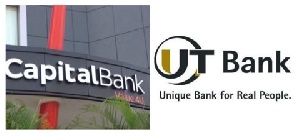The collapse of two indigenous banks; UT and Capital Banks have left in their wake discussions within the industry as to what possible conditions may have triggered the situation.
The Bank of Ghana among others cited the provisions of the Banks and Specialised Deposit-Taking Institutions (SDIs) Act, 2016 as basis for allowing GCB Bank to assume the assets and liabilities of the two local banks. Accountant and Associate Retail Banker, Emmanuel Akrong speaks on this latest development.
He speaks broadly on; circumstances under which a Central Bank revoke a banking license of a bank; definition of receivership or what happens to the liabilities of the insolvent entities; what kind of behavior leads to bank insolvency.
1.Under what circumstances does a Central Bank revoke a banking license of a bank?
In discharging its responsibility of promoting the safety and soundness of banks and specialised deposit-taking institutions and ensuring the soundness and stability of the financial system and the protection of depositors in the country, the Bank of Ghana may revoke the license of any Bank that stands in the way of promoting financial stability and the protection of depositors.
Section 123 of the Banks and Specialised Deposit-Taking Institutions (SDIs) Act, 2016 (Act 930) states that where the Bank of Ghana determines that the bank or specialised deposit-taking institution is insolvent or is likely to become insolvent within the next sixty days, the Bank of Ghana shall revoke the licence of that bank or specialised deposit-taking institution .
Subsection 4 of Act 930 defines “insolvent” as the inability of a bank or specialised deposit-taking institution to pay its obligations as they fall due or the circumstance where the value of the liabilities of a bank or specialised deposit-taking institution exceeds the value of its assets.
Emmanuel’s view: Breaching of the capital adequacy ratio and liquidity ratio are not grounds to revoke a banking license. This is because the penalty of non-compliance with capital requirements as stated in section 33 of Act 930 is not revocation of a banking license but instead the Act says that … A bank, specialised deposit-taking institution or financial holding company which fails to maintain the level of minimum unimpaired paid up capital required under section 28 or the capital adequacy ratio required under sections 29 to 31 is liable to pay to the Bank of Ghana a penalty of one-half per mille of the difference between the capital that the entity should have maintained and the level of capital actually maintained by the entity for each day that the default continues.
A director and the chief executive of a bank or specialised deposit-taking institution which fails to comply with the minimum capital adequacy ratio are personally liable to pay to the Bank of Ghana an administrative penalty of five hundred penalty units.
The penalty for non-compliance with liquidity requirements as stated in section 40 of Act 930 … A bank, specialised deposit-taking institution or financial holding company which fails to hold liquid assets in accordance with section 36 is liable, in addition to any other penalty, to pay interest to the Bank of Ghana at a rate to be prescribed by the Bank of Ghana on the difference between the total amount of liquid assets which it is required to hold and the total amount of liquid assets actually held, in respect of a period during which a difference exists.
In addition to the penalty specified in subsections (3) and (4), a director or chief executive of a non-compliant bank, specialised deposit taking institution or financial holding company is liable to pay to the Bank of Ghana, a penalty in respect of each day during which the deficiency continues of an amount calculated as one half per mille of the deficiency for each day that the deficiency persists.
Although, breaching of the capital adequacy ratio and liquidity ratio are not grounds to revoke a banking license, a continuous breach of the capital adequacy ratio and liquidity ratio may lead a Bank to insolvency.
2) What do we mean by a receivership? What happens to the liabilities of the insolvent entities?
a) Definition of receivership
A Receivership is a remedy available to secured creditors to recover amounts outstanding under a secured loan in the event the company defaults on its loan payments. A Receiver may also be appointed in a shareholder dispute to complete a project, liquidate assets or sell a business.
Typically, the process begins with the appointment of a Receiver either by the secured creditor under a security agreement (“Privately Appointed Receivership”) or by the Court on behalf of a secured creditor (“Court Appointed Receivership”).
Only a Licensed Insolvency Trustee can act as a Receiver. Privately Appointed Receivers will generally only act on behalf of the secured creditor that appointed them and will realize on the assets specifically covered by the loan agreement.
Court Appointed Receivers however, are officers of the Court and act on behalf of all creditors. The powers and rights of Court Appointed Receivers are included in the Court order that appointed them.
3) Do we know what kind of behavior leads to bank insolvency?
Experience indicates that a significant cause of bank failures is poor credit quality and deficient credit risk assessment and measurement practices. Failure to identify and recognise increases in credit risk in a timely manner can aggravate and prolong the problem.
Inadequate credit risk policies and procedures may lead to delayed recognition and measurement of increases in credit risk, which affects the capital adequacy of banks and hampers the proper assessment and control of a bank’s credit risk exposure.
Severe credit losses in a banking system usually reflect simultaneous problems in several areas, such as concentrations, failures of due diligence and inadequate monitoring.
Below is a summary of some of the most common problems related to the broad areas of concentrations, credit processing, and market- and liquidity-sensitive credit exposures
Concentrations Concentrations are probably the single most important cause of major credit problems. Credit concentrations are viewed as any exposure where the potential losses are large relative to the bank’s capital, its total assets or, where adequate measures exist, the bank’s overall risk level. Relatively large losses may reflect not only large exposures, but also the potential for unusually high percentage losses given default.
Credit concentrations can further be grouped roughly into two categories:
– Conventional credit concentrations would include concentrations of credits to single borrowers or counterparties, a group of connected counterparties, and sectors or industries, such as commercial real estate, and oil and gas.
– Concentrations based on common or correlated risk factors reflect subtler or more situation-specific factors, and often can only be uncovered through analysis. Disturbances in Asia and Russia, in late 1998, illustrate how close linkages among emerging markets under stress conditions and previously undetected correlations between market and credit risks, as well as between those risks and liquidity risk, can produce widespread losses. The recurrent nature of credit concentration problems, especially involving conventional credit concentrations, raises the issue of why banks allow concentrations to develop. First, in developing their business strategy, most banks face an inherent trade-off between choosing to specialise in a few key areas with the goal of achieving a market leadership position and diversifying their income streams, especially when they are engaged in some volatile market segments.
This trade-off has been exacerbated by intensified competition among banks and non-banks alike for traditional banking activities, such as providing credit to investment grade corporations.
Concentrations appear most frequently to arise because banks identify “hot” and rapidly growing industries and use overly optimistic assumptions about an industry’s future prospects, especially asset appreciation and the potential to earn above-average fees and/or spreads. Banks seem most susceptible to overlooking the dangers in such situations when they are focused on asset growth or market share.
Credit Process Issues
Many credit problems reveal basic weaknesses in the credit granting and monitoring processes. While shortcomings in underwriting and management of market-related credit exposures represent important sources of losses at banks, many credit problems would have been avoided or mitigated by a strong internal credit process.
Many banks find carrying out a thorough credit assessment (or basic due diligence) a substantial challenge. For traditional bank lending, competitive pressures and the growth of loan syndication techniques create time constraints that interfere with basic due diligence. Globalisation of credit markets increases the need for financial information based on sound accounting standards and timely macroeconomic and flow of funds data.
When this information is not available or reliable, banks may dispense with financial and economicanalysis and support credit decisions with simple indicators of credit quality, especially if they perceive a need to gain a competitive foothold in a rapidly growing foreign market. Finally, banks may need new types of information, such as risk measurements, and more frequent financial information, to assess relatively newer counterparties, such as institutional investors and highly leveraged institutions.
The absence of testing and validation of new lending techniques is another important problem. Adoption of untested lending techniques in new or innovative areas of the market, especially techniques that dispense with sound principles of due diligence or traditional benchmarks for leverage, have led to serious problems at many banks.
Sound practice calls for the application of basic principles to new types of credit activity. Any new technique involves uncertainty about its effectiveness. That uncertainty should be reflected in somewhat greater conservatism and corroborating indicators of credit quality.
An example of the problem is the expanded use of credit-scoring models in consumer lending in the United States and some other countries. Large credit losses experienced by some banks for particular tranches of certain mass-marketed products indicates the potential for scoring weaknesses.
Some credit problems arise from subjective decision-making by senior management of the bank. This includes extending credits to companies they own or with which they are affiliated, to personal friends, to persons with a reputation for financial acumen or to meet a personal agenda, such as cultivating special relationships with celebrities. In some cases, the failure to perform adequate due diligence and financial analysis and to monitor the borrower can result in a breakdown of controls to detect credit-related fraud.
For example, banks experiencing fraud-related losses have neglected to inspect collateral, such as goods in a warehouse or on a showroom floor, have not authenticated or valued financial assets presented as collateral, or have not required audited financial statements and carefully analysed them. An effective credit review department and independent collateral appraisals are important protective measures, especially to ensure that credit officers and other insiders are not colluding with borrowers.
Many banks have experienced credit losses because of the failure to use sufficient caution with certain leveraged credit arrangements. As noted above, credit extended to highly leveraged borrowers is likely to have large losses in default.
Similarly, leveraged structures such as some buyout or debt restructuring strategies, or structures involving customer-written options, generally introduce concentrated credit risks into the bank’s credit portfolio and should only be used with financially strong customers. Often, however, such structures are most appealing to weaker borrowers because the financing enables a substantial upside gain if all goes well, while the borrower’s losses are limited to its net worth.
Many banks’ credit activities involve lending against non-financial assets. In such lending, many banks have failed to make an adequate assessment of the correlation between the financial condition of the borrower and the price changes and liquidity of the market for the collateral assets. Much asset-based business lending (i.e. commercial finance, equipment leasing, and factoring) and commercial real estate lending appear to involve a relatively high correlation between borrower creditworthiness and asset values. Since the borrower’s income, the principal source of repayment, is generally tied to the assets in question, deterioration in the borrower’s income stream, if due to industry or regional economic problems, may be accompanied by declines in asset values for the collateral. Some asset based consumer lending (i.e. home equity loans, auto financing) exhibits a similar, if weaker, relationship between the financial health of consumers and the markets for consumer assets.
A related problem is that many banks do not take sufficient account of business cycle effects in lending. As income prospects and asset values rise in the ascending portion of the business cycle, credit analysis may incorporate overly optimistic assumptions.
Industries such as retailing, commercial real estate and real estate investment trusts, utilities, and consumer lending often experience strong cyclical effects. Sometimes the cycle is less related to general business conditions than the product cycle in a relatively new, rapidly growing sector, such as health care and telecommunications. Effective stress testing which takes account of business or product cycle effects is one approach to incorporating into creditdecisions a fuller understanding of a borrower’s credit risk.
More generally, many underwriting problems reflect the absence of a thoughtful consideration of downside scenarios. In addition to the business cycle, borrowers may be vulnerable to changes in risk factors such as specific commodity prices, shifts in the competitive landscape and the uncertainty of success in business strategy or management direction. Many lenders fail to “stress test” or analyse the credit using sufficiently adverse assumptions and thus fail to detect vulnerabilities.
Market and Liquidity-Sensitive Credit Exposures
Market and liquidity-sensitive exposures pose special challenges to the credit processes at banks. Market-sensitive exposures include foreign exchange and financial derivative contracts. Liquidity-sensitive exposures include margin and collateral agreements with periodic margin calls, liquidity back-up lines, commitments and some letters of credit, and some unwind provisions of securitisations.
The contingent nature of the exposure in these instruments requires the bank to have the ability to assess the probability distribution of the size of actual exposure in the future and its impact on both the borrower’s and the bank’s leverage and liquidity.
Market-sensitive instruments require a careful analysis of the customer’s willingness and ability to pay. Most market-sensitive instruments, such as financial derivatives, are viewed as relatively sophisticated instruments, requiring some effort by both the bank and the customer to ensure that the contract is well understood by the customer.
The link to changes in asset prices in financial markets means that the value of such instruments can change very sharply and adversely to the customer, usually with a small, but non-zero probability.
Effective stress testing can reveal the potential for large losses, which sound practice suggests should be disclosed to the customer. Banks have suffered significant losses when they have taken insufficient care to ensure that the customer fully understood the transaction at origination and subsequent large adverse price movements left the customer owing the bank a substantial amount.
Liquidity-sensitive credit arrangements or instruments require a careful analysis of the customer’s vulnerability to liquidity stresses, since the bank’s funded credit exposure can grow rapidly when customers are subject to such stresses. Such increased pressure to have sufficient liquidity to meet margin agreements supporting over-the-counter trading activities or clearing and settlement arrangements may directly reflect market price volatility In other instances, liquidity pressures in the financial system may reflect credit concerns and a constricting of normal credit activity, leading borrowers to utilise liquidity backup lines or commitments.
Liquidity pressures can also be the result of inadequate liquidity risk management by the customer or a decline in its creditworthiness, making an assessment of a borrower’s or counterparty’s liquidity risk profile another important element of credit analysis.
Market- and liquidity-sensitive instruments change in riskiness with changes in the underlying distribution of price changes and market conditions. For market-sensitive instruments, for example, increases in the volatility of price changes effectively increases potential exposures. Consequently, banks should conduct stress testing of volatility assumptions.
Market- and liquidity-sensitive exposures, because they are probabilistic, can be correlated with the creditworthiness of the borrower
4) To what extent does weak supervision (enforcement of rules) contribute to bank insolvency?
Banks fails everywhere including countries with strong enforcement rules. A Bank does not become insolvent overnight but instead it is a process.
5) What are the main risk factors facing Ghanaian Banks?
Increased credit risk.
Not that I am aware of.
6) What is the global standard in assessing risk of banks and how well is Ghana doing in that regard?
Stress testing by the regulator and Banks required to present stress analysis.
7) Explain the following terms to the layman. Capital Adequacy Ratio; Liquidity Ratio; Non-Performing Loan Ratio. Third Party Fund (TPF).
Capital Adequacy Ratio (CAR) is the ratio of a bank’s capital in relation to its risk weighted assets and current liabilities. It is decided by central banks and bank regulators to prevent commercial banks from taking excess leverage and becoming insolvent in the process.
Capital adequacy ratios are a measure of the amount of a bank’s capital expressed as a percentage of its risk weighted credit exposures.
Applying minimum capital adequacy ratios serves to protect depositors and promote the stability and efficiency of the financial system. Two types of capital are measured – tier one capital which can absorb losses without a bank being required to cease trading, e.g. ordinary share capital, and tier two capital which can absorb losses in the event of a winding-up and so provides a lesser degree of protection to depositors, e.g. subordinated debt. Measuring credit exposures requires adjustments to be made to the amount of assets shown on a bank’s balance sheet.
The loans a bank has made are weighted, in a broad brush manner, according to their degree of riskiness, e.g. loans to Governments are given a 0 percent weighting whereas loans to individuals are weighted at 100 percent. Off-balance sheet contracts, such as guarantees and foreign exchange contracts, also carry credit risks.
These exposures are converted to credit equivalent amounts which are also weighted in the same way as on-balance sheet credit exposures. On-balance sheet and offbalance sheet credit exposures are added to get total risk weighted credit exposures.
Liquidity ratio – The key measure used by Banks for managing liquidity risk is the ratio of net liquid assets to deposits from customers. For this purpose, ‘net liquid assets’ includes cash and cash equivalents and government securities for which there is an active and liquid market less any deposits from Banks, other borrowings and commitments maturing within the next month
[Liquid assets/volatile Liabilities]
Liquid assets =Cash + Cash Reserve Ratio balances with BOG + Balances with banks + Bills purchased/discounted up to 1 year + Investments up to one year + Swap funds (sell/ buy) up to one year + Tradable Government notes and Bonds.
Volatile Liabilities: [demand deposits, District Assembly Common Funds (DACF), All Governments Instruments which could be called at short notice] etc.
Non-Performing Loan Ratio : Nonperforming loans to total gross loans ratio is calculated by using the value of nonperforming loans (NPLs) as the numerator and the total value of the loan portfolio (including NPLs, and before the deduction of specific loan- loss provisions) as the denominator.
It is often used as a proxy for asset quality and is intended to identify problems with asset quality in the loan portfolio Loans are considered to be non-performing or in default when they are equal to or greater than 90 days in arrears or where management believes a loss may be incurred.
If one bank displays a higher level of non-performing assets than another bank during a year, this does not necessarily mean that the first bank experienced a higher level of credit losses during the year. This may be because the first bank’s non-performing assets were residential mortgages, which are normally more highly collateralized than other types of lending. Alternatively, the second bank may simply have written off its non-performing assets more quickly than the first bank, in an attempt to display a healthier loan book to investors and ratings agencies.
The Bank of Ghana requires Banks to categorize a loan based on the assets quality (which is based on number of days in delinquency and other qualitative factors that affect the borrower’s ability to make the loan’s contractual payments into current, Other loans especially mentioned (“OLEM”), sub-standard and loss).
Current – Advances in the current category are those for which the borrower is up to date (i.e. current) with repayments of both principal and interest.
Olem- Advances in Olem category are currently protected by adequate security, both as to principal and interest, but they are potentially weak and constitute an undue credit risk, although not to the point of justifying the classification of substandard.
Substandard advances display well-defined credit weaknesses that jeopardise the liquidation of the debt.
Doubtful advances exhibit all the weaknesses inherent in advances classified as substandard with the added characteristics that the advances are not well-secured and the weaknesses make collection or liquidation in full, on the basis of currently existing facts, conditions and values, highly questionable and improbable.
The loss category represents exposures that are considered uncollectable and of such little value that their continuation as recoverable advances is not warranted. The loss category of non-performing loans recorded a phenomenal increase from GH¢0.13 billion to GH¢2.5 billion from 2007 to 2015. The loss category dominated the stock of NPL over the nine years period, with an NPL coverage ratio (ratio of loan loss reserves to total NPL) averaging around 55 percent.
8) What ought to be done to restore confidence in the sector?
Subsection 2 (d) of section 3 of Act 930 states that the Bank of Ghana is responsible for developing appropriate consumer protection measures to ensure that the interests of clients of the banks and the specialised deposit-taking institutions are adequately protected.
Accordingly, the Bank of Ghana has set up Consumer Reporting Office (ICRO) as the financial industry watchdog office of the Bank of Ghana (BOG), with responsibility for protecting consumers of financial products/services and educating them on their rights and responsibilities. It is an office within the Banking Supervision Department (BSD).
In pursuance of Section 7 of the Borrowers and Lenders Act, 2008 (Act 773), the Bank of Ghana hereby on this 10TH February 2017, issues the Disclosure and Product Transparency Rules for Credit Products and Services, for compliance by all Lenders offering such Credit products and operating in Ghana. The objectives of these Rules are –
(i) To foster public confidence and trust in the banking sector and to promote financial stability, growth and efficiency.
(ii) To protect borrowers and businesses by promoting fair banking practices.
(iii) To educate, increase transparency and disclosure practices to better inform borrowers.
(iv) To provide efficient and effective mechanisms for handling consumer complaints relating to the provision of financial services.
(v) To Promote equitable banking practices by setting minimum standards for borrowers in dealing with financial service providers
vi) To foster competition and allow market forces to operate and encourage higher standards for the benefit of financial service providers.
In pursuance of Section 3 (2) (d) and Section 92 (2) (a) (xi) of the Banks and Specialised Deposit-Taking Institutions Act, 2016 (Act 930), the Bank of Ghana hereby on this 10th day of February, 2017 issues the Consumer Recourse Mechanism Guidelines for Financial Service Providers, 2017, for compliance by all banking and non- banking institutions regulated by the Bank of Ghana These directives are to ensure:
a) That consumers have access to adequate complaints handling and redress mechanisms that are accessible, independent, fair, accountable, timely and efficient;
b) That the complaint mechanisms do not impose unreasonable cost, cause undue delay or impose a burden on consumers; c) That consumers and businesses are protected through the promotion of fair banking practices; d) The fostering of public confidence and trust in the banking sector and thus promote financial stability, growth and efficiency in the banking sector; e) That the public is educated on their right to redress in order to promote fairness in the banking sector.
I believe the establishment of ICRO with the issuance of the above two regulations will go a long way to promote Confidence, Discipline and Harmony in the Banking Industry.
In addition, the Bank of Ghana (BoG) has served notice that it will begin the implementation of the Ghana Depository Protection Act, 2016 (Act 931) The Act which was passed by Parliament in 2016 is expected to protect depositors from unforeseen circumstances that may result in loss of funds. According to the law, depositors whose monies get locked up in financial institutions during crisis may receive up to GH¢6,250 in compensation. This will be paid by the Deposit Protection Fund Corporation.
The new legislation would help the BoG to protect small depositors in the financial sector.
Accountant and Associate Retail Banker, Emmanuel Akrong
Business News of Monday, 28 August 2017
Source: Emmanuel Akrong, Accountant and Associate Retail Banker
8 key Q&A s on collapse of UT, Capital Bank
Entertainment
















